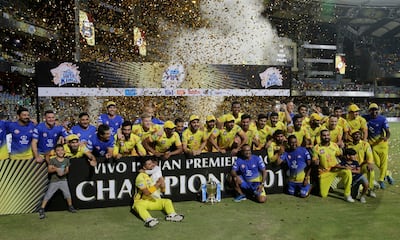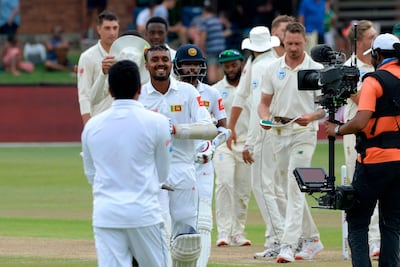Is Test cricket going to die? It is a thought that has festered in the minds of the game's administrators, players and supporters since the advent of one-day internationals in 1971.
Tests have indeed survived one wave of change after another to hit the game's shores over the past nearly five decades – through the launch of the Cricket World Cup in 1975, the creation of the breakaway World Series Cricket two years later, and the arrival of Twenty20, the game's shortest format at international level, in 2005.
But the scope of the existential threat has been magnified in recent times by the changing tastes of the paying public.
The International Cricket Council (ICC), the sport's governing body, has pinned its hopes of keeping the format alive on the inaugural World Test Championship, which is due to launch in July – but more on this later.
So why is the health of the five-day game, which celebrates its 142nd birthday next week, a topic of discussion at the moment? Read on.

The MCC survey
The London-based Marylebone Cricket Club (MCC) – the custodians of the game's laws – recently surveyed more than 13,000 responders from more than 100 countries asking them what their preferred format was. An overwhelming 86 per cent of the fans voted for Test cricket, according to a statement issued by the MCC on Saturday.
"Responders still consider the Test format to be the pinnacle of cricket and the favourite format of cricket to attend, follow and watch, with respondents describing the game as the 'ultimate' form of cricket," the MCC said.
While the debate about the future of the long format is not new, what was the need to conduct a survey at this point in time? Presumably, it was partly in response to remarks made on the topic by the ICC chairman last month.
"Test cricket is actually dying to be honest," Shashank Manohar said during a reception hosted by the Bangladesh Cricket Board in February. "So to improve the situation, we are trying ways and means."
The MCC's survey showed responders did not agree with Manohar's assertion, which will have come as good news to many purists who look down on the shorter formats.

Does Manohar not have a point?
He does to a certain extent.
The heart of the matter is most people do not have the time or patience to watch whole Test matches, which are played over seven hours every day for five days.
The lion's share of the viewers come from the subcontinent, form the core of the middle-class, live in cities and have 9-5 jobs. Seeing as this growing segment of the population cannot afford to watch a full game on television, let alone go to a stadium, the long-term viability of Test cricket remains an issue.
The commercialisation and monetisation of the sport, which began in the late 70s, have given viewers and consequently players more options to choose from. There was a glut of international competitions even before T20 leagues began mushrooming around the world during the past decade.
Today, the Indian Premier League, the Big Bash League and the Pakistan Super League have all become incredibly successful among fans not just in established cricketing nations but also emerging ones. And the lure of quick money has spawned several T20 freelancers, while many players have signed white ball-only contracts in English county cricket making their priority clear.
"If you look at the TRPs of the broadcasters, T20 has the maximum TRP," Manohar explained of the impact it has had on TV ratings. "It is because of being the shorter version of the game. Nowadays, people don't have five days time to watch a Test match. From 10 to 5 everybody has their own job to do so it is very difficult for them to watch this game.
"T20s get over in three-and-a-half hours, like watching a movie. Therefore, it is picking up very fast."

Has the survey got it wrong then?
It has not, for the number of people who grew up watching Test cricket and continue to love it is still significant. Besides, the recent competitiveness among Test-playing nations has probably added to the positivity among the survey's responders.
The past couple of months have been a great advertisement for the long form, with India registering their first ever Test series victory in Australia, West Indies humbling England, and Sri Lanka becoming the first Asian country to win a series in South Africa.
"Test cricket has had the most incredible year and that has contributed to the strong support for Test cricket," said Sri Lankan batting great Kumar Sangakkara, a member of the MCC World Cricket Committee.
"There’s huge competition amongst the top countries at the moment and it makes for exciting competition. It is brilliant news fans are backing the great cricket being played the world over."
Dave Richardson, the ICC's outgoing chief executive, has himself disagreed with Manohar and provided a strong piece of evidence to support the notion that Test cricket is in decent shape.
"We have got more than a billion fans that follow cricket – 68 per cent of them are fans of all three formats of the game, which means that close to 700 million people are fans of Test cricket," Richardson said last month. "So it is wrong to say that Test cricket is dying."
The former South Africa wicketkeeper-batsman, however, pointed to a change in viewing habits. "Maybe the way that people are following Test cricket is different to what it was say 10, 20 years ago," he said.
For instance, while people may not be able to watch entire matches, they are taking short breaks from work to catch a glimpse of the action. There are those following the scores online, so the interest is definitely there.
Richardson's point is also instructive in that cricket will continue to offer multiple options of entertainment that fans can pick and choose from.

The solutions
Whether you agree that Test cricket is dying or not, there is little debate that it faces a few hurdles.
The MCC survey did point to key challenges in increasing attendances at and viewership of Tests, including cost and availability of ticket and increased access in free-to-air TV. Also, how do you persuade children growing up on a T20 diet to pay more attention to five-day matches.
The ICC is working on solutions, as Manohar pointed out.
There is hope the World Test Championship, to be launched this year, will give Test cricket more relevance. Bilateral series, with the exception of the Ashes, have for a long time been suffering from a lack of context. It is fair to ask, for instance, what the big deal is about India beating England in their own backyard or vice versa.
Does this make for better viewing?
... or does this make for better viewing?
The Test championship solution, first proposed in 2009 but approved only in 2017, aims to tie these meaningless bilateral exchanges into a larger competition played over two years. In essence, it is the Test world cup.
There are other solutions in the research-and-development phase – including day-night games and four-day matches – which no doubt have their issues but nonetheless are worth trying out if only to make the game more palatable to the modern viewer.
A suggestion worth giving some thought, one that was offered by The National's Paul Radley, is playing Tests at smaller venues which are easier to fill with spectators. Granted this might be for cosmetic effect. But small venues are more intimate. Just visit the ICC Academy Ground in Dubai Sports City and the nurseries around Zayed Cricket Stadium in Abu Dhabi.
Broadcasters might be hard to persuade given the logistical challenges of covering matches inside small arenas. But even they will agree stands packed with people will help lift the morale of the players and make for good TV.


